
Owner???s Manual
 HARDWARE GUIDE
HARDWARE GUIDE

Owner???s Manual
 HARDWARE GUIDE
HARDWARE GUIDE

Before using this unit, carefully read the sections entitled: ???USING THE UNIT SAFELY??? (p. 3) and ???IMPORTANT NOTES??? (p. 5). These sections provide important information concerning the proper operation of the unit. Additionally, in order to feel assured that you have gained a good grasp of every feature provided by your new unit, Owner???s Manual should be read in its entirety. The manual should be saved and kept on hand as a convenient reference.
*Microsoft, Windows and Windows Vista are registered trademarks of Microsoft Corporation.
*The screen shots in this document are used in compliance with the guidelines of the Microsoft Corporation.
*Windows?? is known officially as: ???Microsoft?? Windows?? operating system.???
*ASIO is a trademark of Steinberg Media Technologies GmbH.
*Cakewalk is a registered trademark of Cakewalk Inc.
*Cakewalk logo is a trademark of Cakewalk Inc.
*MMP (Moore Microprocessor Portfolio) refers to a patent portfolio concerned with microprocessor architecture, which was developed by Technology Properties Limited (TPL). Roland has licensed this technology from the TPL Group.
*All product names mentioned in this document are trademarks or registered trademarks of their respective owners.
Copyright ?? 2010 ROLAND CORPORATION
All rights reserved. No part of this publication may be reproduced in any form without the written permission of
ROLAND CORPORATION.
2
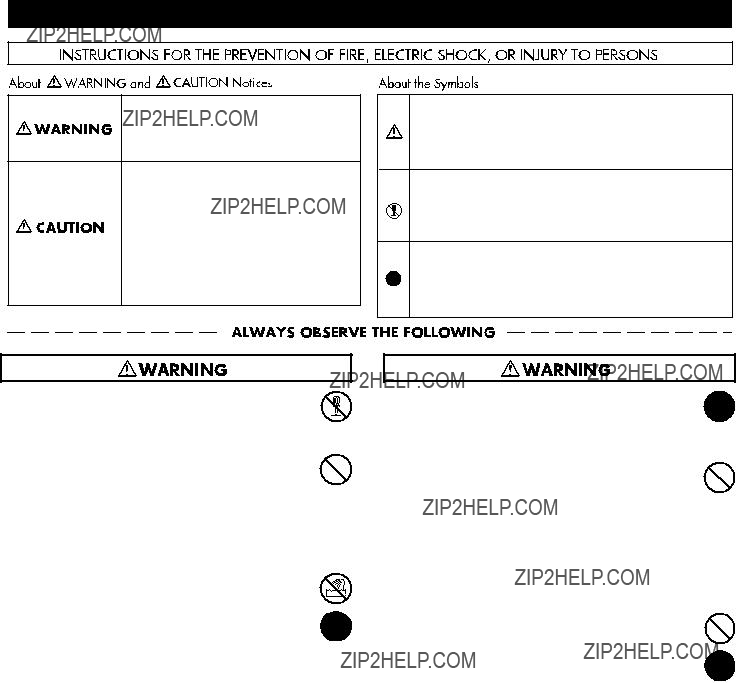
Used for instructions intended to alert the user to the risk of death or severe injury should the unit be used improperly.
Used for instructions intended to alert the user to the risk of injury or material damage should the unit be used improperly.
* Material damage refers to damage or other adverse effects caused with respect to the home and all its furnishings, as well to domestic animals or pets.
???Do not open or perform any internal modifications on
the unit.
....................................................................................................................
???Do not attempt to repair the unit, or replace parts within it (except when this manual provides specific instructions directing you to do so). Refer all servicing to your retailer, the nearest Roland Service Center, or an
authorized Roland distributor, as listed on the ???Information??? sheet.
....................................................................................................................
??? Never install the unit in any of the following locations.
??? Subject to temperature extremes (e.g., direct sunlight in an enclosed vehicle, near a heating duct, on top of
???Damp (e.g., baths, washrooms, on wet floors); or are
???Exposed to steam or smoke; or are
???Subject to salt exposure; or are
???Humid; or are
???Exposed to rain; or are
???Dusty or sandy; or are
???Subject to high levels of vibration and shakiness.
....................................................................................................................
The  symbol alerts the user to important instructions or warnings.The specific meaning of the symbol is determined by the design contained within the triangle. In the case of the symbol at left, it is used for general cautions, warnings, or alerts to danger.
symbol alerts the user to important instructions or warnings.The specific meaning of the symbol is determined by the design contained within the triangle. In the case of the symbol at left, it is used for general cautions, warnings, or alerts to danger.
The  symbol alerts the user to items that must never be carried out (are forbidden). The specific thing that must not be done is indicated by the design contained within the circle. In the case of the symbol at left, it means that the unit must never be disassembled.
symbol alerts the user to items that must never be carried out (are forbidden). The specific thing that must not be done is indicated by the design contained within the circle. In the case of the symbol at left, it means that the unit must never be disassembled.
The ??? symbol alerts the user to things that must be carried out. The specific thing that must be done is indicated by the design contained within the circle. In the case of the symbol at left, it means that the
???Make sure you always have the unit placed so it is level and sure to remain stable. Never place it on stands that could wobble, or on inclined surfaces.
....................................................................................................................
???This unit, either alone or in combination with an amplifier and headphones or speakers, may be capable of producing sound levels that could cause
permanent hearing loss. Do not operate for a long period of time at a high volume level, or at a level that is uncomfortable. If you experience any hearing loss or ringing in the ears, you should immediately stop using the unit, and consult an audiologist.
....................................................................................................................
???Do not allow any objects (e.g., flammable material, coins, pins); or liquids of any kind (water, soft drinks, etc.) to penetrate the unit.
....................................................................................................................
3

USING THE UNIT SAFELY
???Immediately turn the power off, and request servicing
by your retailer, the nearest Roland Service Center, or an authorized Roland distributor, as listed on the ???Information??? sheet when:
???Objects have fallen into, or liquid has been spilled onto the unit; or
???If smoke or unusual odor occurs
???The unit has been exposed to rain (or otherwise has become wet); or
???The unit does not appear to operate normally or exhibits a marked change in performance.
....................................................................................................................
???In households with small children, an adult should
provide supervision until the child is capable of following all the rules essential for the safe operation of the unit.
....................................................................................................................
???Protect the unit from strong impact. (Do not drop it!)
....................................................................................................................
???DO NOT play a
....................................................................................................................
???Try to prevent cords and cables from becoming
entangled. Also, all cords and cables should be placed so they are out of the reach of children.
....................................................................................................................
???Never climb on top of, nor place heavy objects on the unit.
....................................................................................................................
???Disconnect all cords coming from external devices before moving the unit.
....................................................................................................................
???Always turn the phantom power off when connecting
any device other than condenser microphones that  require phantom power. You risk causing damage if you mistakenly supply phantom power to dynamic microphones, audio playback devices, or other devices that don???t require such power. Be sure to check the specifications of any micro- phone you intend to use by referring to the manual that came with it.
require phantom power. You risk causing damage if you mistakenly supply phantom power to dynamic microphones, audio playback devices, or other devices that don???t require such power. Be sure to check the specifications of any micro- phone you intend to use by referring to the manual that came with it.
(This instrument???s phantom power: 48 V DC, 10 mA Max)
....................................................................................................................
4


 Important Notes
Important Notes
Power Supply
???Before connecting this unit to other devices, turn off the power to all units. This will help prevent malfunctions and/or damage to speakers or other devices.
Placement
???Using the unit near power amplifiers (or other equipment containing large power transformers) may induce hum. To alleviate the problem, change the orientation of this unit; or move it farther away from the source of interference.
???This device may interfere with radio and television reception. Do not use this device in the vicinity of such receivers.
???Noise may be produced if wireless communications devices, such as cell phones, are operated in the vicinity of this unit. Such noise could occur when receiving or initiating a call, or while conversing. Should you experience such problems, you should relocate such wireless devices so they are at a greater distance from this unit, or switch them off.
???Do not expose the unit to direct sunlight, place it near devices that radiate heat, leave it inside an enclosed vehicle, or otherwise subject it to temperature extremes. Excessive heat can deform or discolor the unit.
???When moved from one location to another where the temper- ature and/or humidity is very different, water droplets (conden- sation) may form inside the unit. Damage or malfunction may result if you attempt to use the unit in this condition. Therefore, before using the unit, you must allow it to stand for several hours, until the condensation has completely evaporated.
???Depending on the material and temperature of the surface on which you place the unit, its rubber feet may discolor or mar the surface.
You can place a piece of felt or cloth under the rubber feet to prevent this from happening. If you do so, please make sure that the unit will not slip or move accidentally.
Maintenance
???For everyday cleaning wipe the unit with a soft, dry cloth or one that has been slightly dampened with water. To remove stubborn dirt, use a cloth impregnated with a mild, non- abrasive detergent. Afterwards, be sure to wipe the unit thoroughly with a soft, dry cloth.
???Never use benzine, thinners, alcohol or solvents of any kind, to avoid the possibility of discoloration and/or deformation.
Additional Precautions
???Use a reasonable amount of care when using the unit???s buttons, sliders, or other controls; and when using its jacks and connectors. Rough handling can lead to malfunctions.
???When connecting / disconnecting all cables, grasp the connector
???To avoid disturbing your neighbors, try to keep the unit???s volume at reasonable levels. You may prefer to use headphones, so you do not need to be concerned about those around you (especially when it is late at night).
???When you need to transport the unit, package it in the box (including padding) that it came in, if possible. Otherwise, you will need to use equivalent packaging materials.
???Use only the specified expression pedal (Roland
???Some connection cables contain resistors. Do not use cables that incorporate resistors for connecting to this unit. The use of such cables can cause the sound level to be extremely low, or impossible to hear. For information on cable specifications, contact the manufacturer of the cable.
5

Important Notes
Handling
???Avoid touching or scratching the shiny underside (encoded surface) of the disc. Damaged or dirty
Copyright
???Recording, duplication, distribution, sale, lease, performance, or broadcast of copyrighted material (musical works, visual works, broadcasts, live performances, etc.) belonging to a third party in part or in whole without the permission of the copyright owner is forbidden by law.
???This product can be used to record or duplicate audio or visual material without being limited by certain technological
???Do not use this unit for purposes that could infringe on a copyright held by a third party. We assume no responsibility whatsoever with regard to any infringements of
6

About This Manual
This manual
???This manual uses the following icons to call your attention to explanations of terms or to important points you should note. These contain important information, so please be sure to read them.
Explanation of terms, or tips
Points you should be aware of
Related information or detailed explanations
???In order to explain operations as simply as possible, this manual uses the following conventions.
???The steps for selecting a menu item are delineated by ???|??? (vertical bar) symbols. For example, File|New means that you are to choose the ???File menu command New.???
???Material that is distinct from the main text or operating procedure, such as operating tips or related information, is enclosed by a heavy border.
???Unless otherwise specified, Windows 7, Windows Vista and Windows XP are referred to simply as Windows.
???Unless otherwise specified, the Guitar Tracks 4 software included with this product is referred to simply as
???
???If you have difficulty understanding the explanations included in this manual (for example, when you???re using Windows for the first time), please refer to the documentation for your computer or for Windows.
???The explanations in this manual include illustrations that depict what should typically be shown by the display. Note, however, that your unit may incorporate a newer, enhanced version of the system (e.g., includes newer sounds), so what you actually see in the display may not always match what appears in the manual.
7


 Contents
Contents
8

9
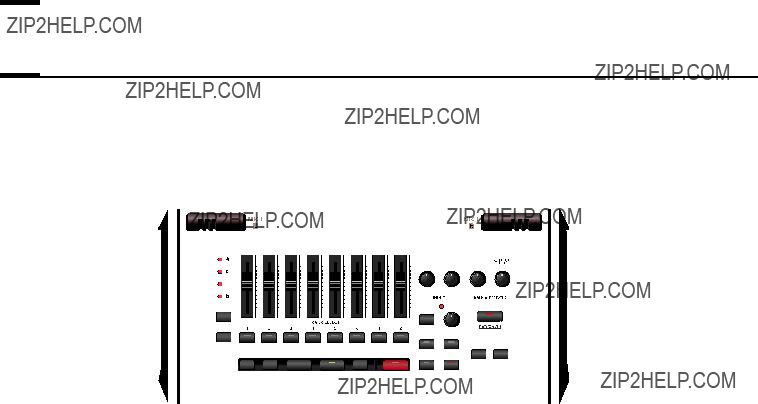

 Checking the Contents of the Package
Checking the Contents of the Package
As soon as you open the package, check that you have all of the included items.
If anything is missing, contact your dealer.
???
??? Owner???s Manual
This is the manual you???re reading. It explains how to get
???
This
??? USB cable
Use this cable to connect the
???
This is an easy manual for the setup of the
??? Customer service leaflet
This tells you where to direct your questions about operation.
10


 Installation and Registration
Installation and Registration
Here???s how to install the
DO NOT CONNECT THE
Guitar Tracks 4 cannot be installed unless the
Please note before installing
When installing, you must log on as a user with administrative privileges
In order to install Guitar Tracks 4, you must log on as a user who has administrative privileges. Once installed, the program can also be used by users who do not have administrative privileges.
Close system monitoring software before installing
If system monitoring software such as
Installing the
What is a Driver?
A driver is software that transfers data between the
Log on to Windows as ???Administrator???, or with an account that has administrator rights.
???Windows 7 and Windows Vista Users:p. 12
???Windows XP Users:p. 14
11

Installation and Registration
Windows 7/Vista Users
1.Disconnect all USB cables (except those for a USB keyboard and/or USB mouse, if used), then start up Windows.
2.Close all currently running software (applications).
Also close all windows that are open. If you are using software such as antivirus programs, be sure to close these programs as well including any monitoring software such as
3.Insert the included
If you are using a Netbook or do not have a
to register your product and download the software installers included on the
4.Select
(where d:\ is your disc drive.)
Please be sure to select the correct driver for your operating system. x64 and x32 drivers are included on the
???x64Drivers\Win7 folder (for Windows 7
???Drivers\Win7 folder (for Windows 7
???x64Drivers\Vista folder (for Windows Vista
???Drivers\Vista folder (for Windows Vista
If a message informs you that ???Driver installation must be performed by an administrator,??? you must log on to Windows as a user whose Account Type is Administrator, and then perform the installation.
5.A confirmation screen regarding User Account Control appears, click [Continue].
6.The message
* If any other message appears, follow the directions of the message.
7.Click [Next] to begin installation.
12

Installation and Registration
8.If a dialog box regarding Windows Security appears, click [Install].
9.The message ???Ready to install the driver.??? appears.
Leave the screen open; do not close it at this point.
* If any other message appears, follow the directions of the message.
10.Perform the following procedure before you connect the
1.Minimize the
DIRECT
2.Use the included USB cable to connect the
3.The lower right corner of the screen will indicates ???Installing device driver software,??? and the driver will be installed automatically.
* If any other message is displayed, note the contents and close the message.
4.When the ???Installation has been completed.??? message appears, installation has been completed. Click [Close] to close the ???Driver Setup??? dialog box.
5.If the ???System Settings Change??? dialog box appears, click [Yes] to restart Windows.
It is very important the driver is installed successfully before installing other components. Please be sure to follow all instructions and verify the ???Installation has been completed??? messages appears before continuing. If the installation was not completed successfully, disconnect the USB cable from the
13
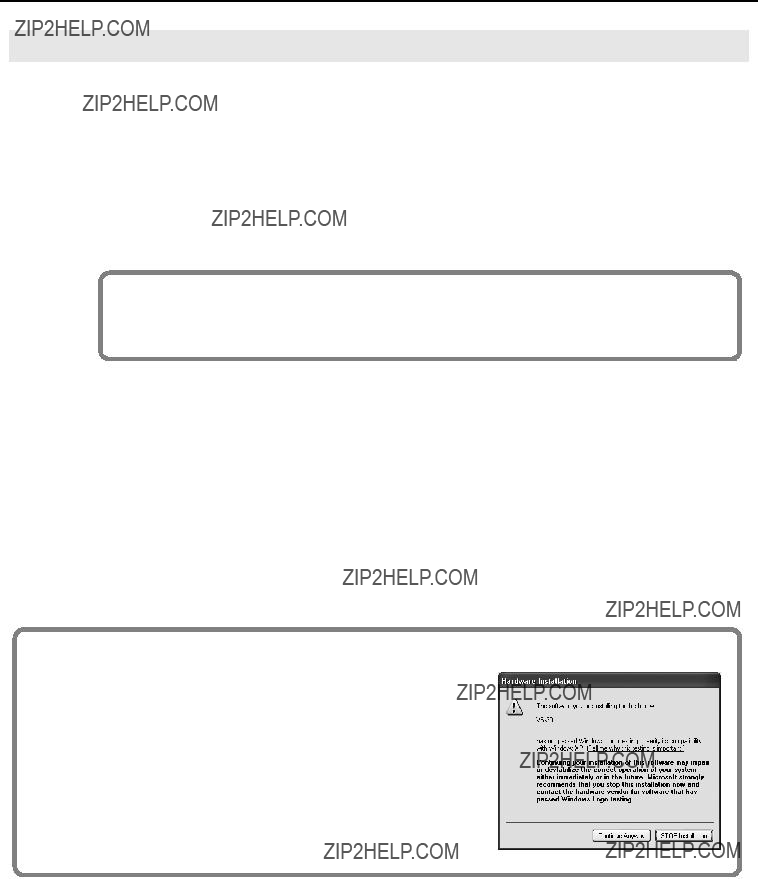
Installation and Registration
Windows XP Users
1.Disconnect all USB cables (except those for a USB keyboard and/or USB mouse, if used), then start up Windows.
2.Close all currently running software (applications).
Also close all windows that are open. If you are using software such as antivirus programs, be sure to close these programs as well.
3.Insert the included
If you are using a Netbook or do not have a
to register your product and download the software installers included on the
4.Select
(where d:\ is your disc drive).
* If a ???Install Program As Other User??? dialog box appears, click [Cancel] to quit the installation and then perform the installation as an administrative account.
5.The message
* If any other message appears, follow the directions of the message.
6.Click [Next] to begin installation.
* If the ???Software Installation??? dialog box appears, click [Continue Anyway] to proceed with the installation.
If the ???Driver Signing Options??? setting was not set to ???Ignore,??? a ???Hardware Installation??? dialog box appears.
A dialog box with a ???!??? symbol appears.
1.Click [Continue Anyway] and continue the installation.
A dialog box with a ???x??? symbol appears.
1.Click [OK].
2.When the ???Found New Hardware Wizard??? appears, click [Finish].
3.Return to step 1 (p. 14) and
14

Installation and Registration
7.The message ???Ready to install the driver.??? appears.
Leave the screen open; do not close it at this point.
* If any other message appears, follow the directions of the message.
8.Perform the following procedure before you connect the
1.Minimize the
DIRECT
2.Use the included USB cable to connect the
3.Wait until the lower right of the screen indicates ???Found New Hardware??? and the ???Found New Hardware Wizard??? appears.
* It may take some time for the ???Found New Hardware Wizard??? to appear.
4.If you are asked whether you want to connect to Windows Update, choose ???No??? and then click [Next].
5.Choose ???Install the software automatically (Recommended)??? and click [Next].
6.If the ???Hardware Installation??? dialog box appears, click [Continue Anyway] to proceed with the installation.
*If you cannot proceed with the installation, click [OK] to cancel the installation, and then refer to ???Driver Signing Options setting.???
7.If the ???Completing the Found New Hardware Wizard??? appears, Click [Finish].
When the ???Installation has been completed.??? message appears, installation has been completed. Click [Close] to close the ???Driver Setup??? dialog box.
8.If the ???System Setting Change??? dialog box appears, click [Yes] to restart Windows.
It is very important the driver is installed successfully before installing other components. Please be sure to follow all instructions and verify the ???Installation has been completed??? messages appears before continuing. If the installation was not completed successfully, disconnect the USB cable from the
15

Installation and Registration
Connecting your audio equipment
Before connecting the
Driver (p. 11) and install the
Guitar Tracks 4 cannot be operated correctly from the computer.
???Use a USB cable to connect your computer to the
???Connect your audio output devices such as headphones or speakers to the
You must connect headphones or monitor speakers as shown in the illustration, monitor the playback audio from the
To prevent malfunction and/or damage to speakers or other devices, always turn down the volume, and turn off the power on all devices before making any connections.
Monitor amplified speakers
Headphones
USB
Cable
Computer
16

Installation and Registration
Installing
To Install Guitar Tracks 4
1.Place the
2.Select
3.Follow the installation instructions on the screen.
To Install
1.Place the
2.Select
3.Follow the installation instructions on the screen.
Register
Before you install
http://www.cakewalk.com/register,
or call
http://www.cakewalk.com/ Dealers/International.asp
to get the telephone number of your local distributor.
You???ll need to supply your serial number, your name, and a valid email address.
17
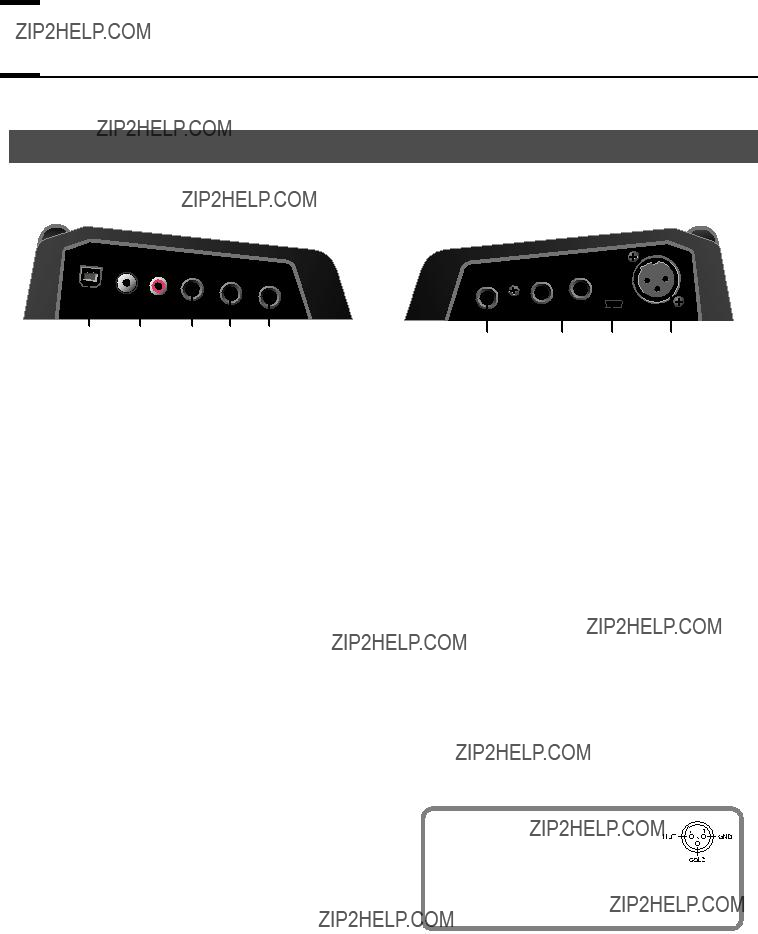

 Panel Descriptions
Panel Descriptions
Input/output component
1.USB connector
Use a USB cable to connect the
1.GUITAR/BASS
This is an input jack for connecting an electric guitar, bass, or
2.OUTPUT L and R (RCA pin output jack)
Analog audio signal output jacks. The effect sound and the signal from your computer are mixed and output here.
3.Footswitch jack
You can use the foot switch (sold separately) to control playback or recording on the
For more information about footswitch, see
2.LINE L/R
These input jacks for connecting
3.Security slot ( )
)
Connect a commercially available
http://www.kensington.com/
4.EXP PEDAL jack
Connect an expression pedal (sold separately). The expression pedal can be used to control the volume, or as a wah effect pedal. See Connecting footswitches (optional) (p. 23).
5.Headphone output
This output delivers the same signal as the MAIN output. To adjust the headphone volume, use the
[Output Level] knob.
4.MIC 2 (XLR balanced input)
This is an analog audio signal input jack that supports XLR balanced input.
* The
phantom power, start up the editor, click System Settings, and turn on phantom power.
This instrument is equipped with
balanced (XLR) type jacks. Wiring diagrams for these jacks are shown below. Make connections after first
checking the wiring diagrams of other equipment you intend to connect.
18
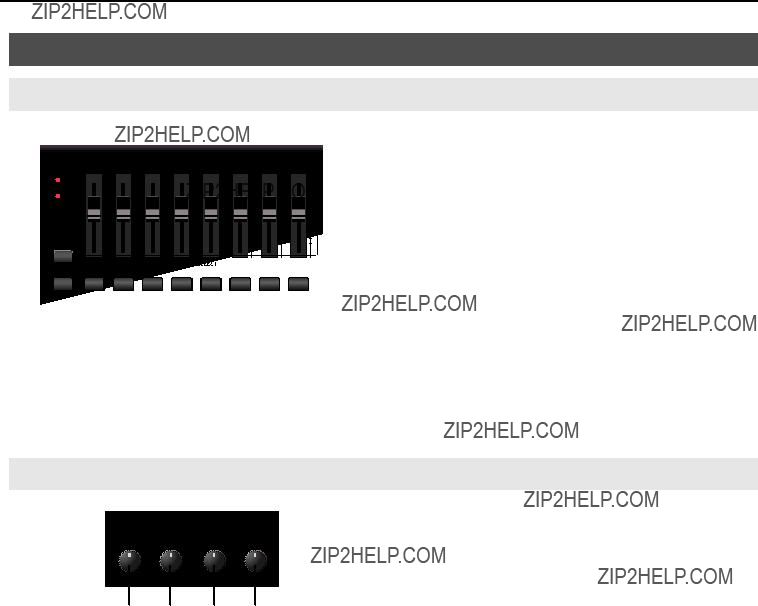
Panel Descriptions
Top panel
Track section
This section controls the tracks.


















 1 2
1 2



















 3
3
1.Stereo audio track fader
Use this to adjust the level for each track in Guitar Tracks.
2.Track group select buttons/indicators
Here you can select one of the track groups ???A/B/C/D.???
Output section
1.MIDI BACKING knob
This controls the MIDI Backing Track volume within the Guitar Tracks 4 software.
2.DAW OUTPUT knob
This controls the overall volume of the tracks in Guitar Tracks.
* The MIDI BACKING knob and DAW OUTPUT knob are used when Guitar Tracks 4 software is running.
The indicator shows the currently selected track group.
There are four track groups
By switching between track groups you can view eight tracks at a time.
3.TRACK SELECT buttons/indicators
These buttons select the track to be recorded. The indicator of the selected track will light.
3.DIRECT MONITOR knob
This controls the level of the output from the effects processor that's built into the
4.OUTPUT LEVEL knob
This controls the overall volume to the headphones and speakers when connected to the
19

Panel Descriptions
Input section
1 
 2
2
3 
 5 4
5 4 
 6
6
1.[TUNER] button
If you press this while the editor is running, the Tuner in the
Here you can tune your instrument.
2.SENS knob/PEAK indicator
This adjusts the sensitivity of the signal that's being input to the MIC 1, MIC 2, LINE, and GUITAR/BASS jacks. If an excessive input signal is detected, the PEAK indicator will light.
For the best possible recording quality, input the signal and adjust the [SENS] knob until it is as high as you can get it without causing the PEAK indicator to light.
3.[MIC 1] button
This button enables the signal input from MIC 1 (built- in stereo mics).
4.[MIC 2] button
This button enables the signal input from MIC 2 jack.
5.[LINE] button
This button enables the signal input from LINE jacks.
6.[GUITAR/BASS] button
This button enables the signal input from GUITAR/BASS jack.
By pressing [MIC 2] and [GUITAR/BASS] simultaneously, you can make input settings for
Transport section
Here you can control the
1.[ ] button
] button
Press this button to move the Now Time to the beginning of the project.
2.[ ] button
] button
Press this button to rewind the Now Time.
3.[  ] button
] button
Press this button to stop playback.
4.[  ] button
] button
Press this button to start playback.
If you press this button during playback, the playback pauses. Press again, to resume playback.
5.[ ] button
] button
Press this button to
6.[  ] button
] button
Press this button to start recording on tracks that are selected for recording (record enabled).
If you press this button during playback, you can start recording tracks that are
20

Panel Descriptions
AMP&EFFECT section
1
2
1.[COSM] button/indicator
This switches the effect between on and bypass.
If this indicator is lit, you will hear the input sound with the effects. If the indicator is unlit, the effects will be bypassed and you will hear the input sound only.
* The [COSM] button can be used when the included
You can start up
when the included
21
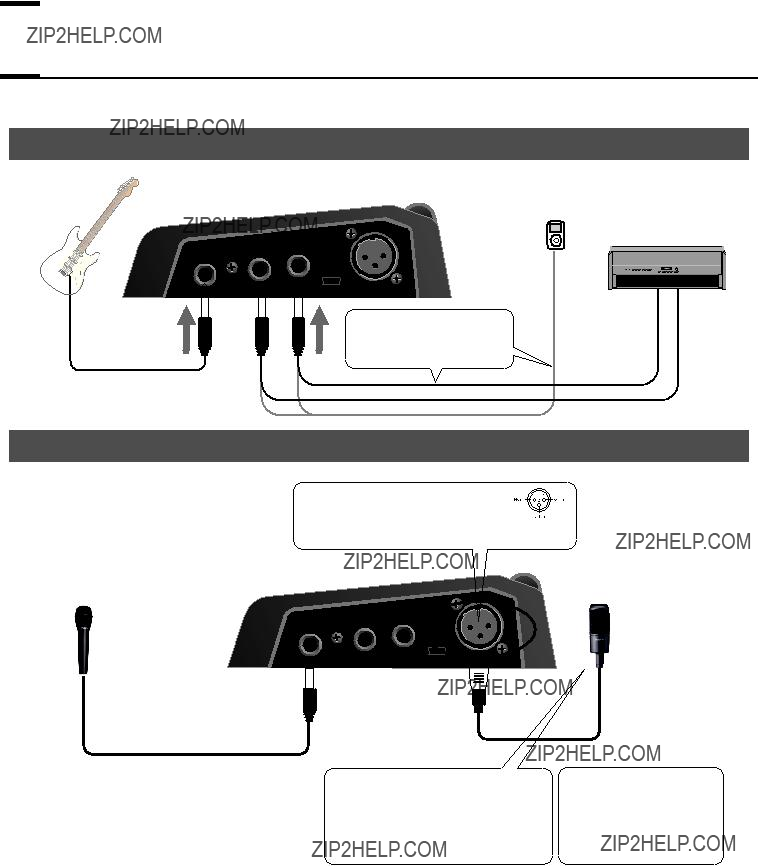

 Connections
Connections
Connecting musical instruments
Synthesizer, or other device
Use a commercially available cable that???s appropriate for the device to which you are connecting.
Connecting microphone
Microphone with a phone plug
The
Microphone with an XLR plug
If you???re using a condenser microphone that has a balanced (XLR) plug and requires phantom power to be supplied, set the
You must turn phantom power off unless you???re using a condenser mic that requires a phantom power supply. Malfunctions will occur if phantom power is supplied to a dynamic microphone or audio playback device. For details on the specifications of your microphone, refer to its owner???s manual.
22
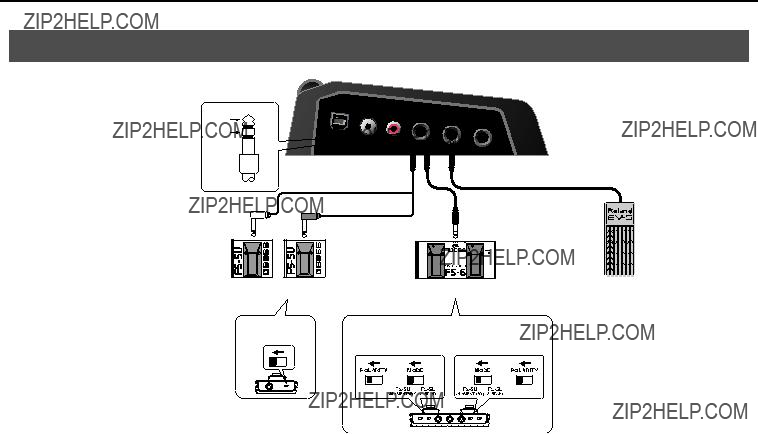
Connections
Connecting footswitches (optional)
You can use footswitches to control the Guitar Tracks 4.
*Footswitch pedal and Expression pedal are not included.
*When connection cables with resistors are used, the volume level of equipment connected to the INPUT connectors may be low. If this happens, use connection cables that do not contain resistors.
*Howling could be produced depending on the location of microphones relative to speakers. This can be remedied by:
1.Changing the orientation of the microphone(s).
2.Relocating microphone(s) at a greater distance from speakers.
3.Lowering volume levels.
*Do NOT connect anything to input terminals that you are not using.
*Use only the specified expression pedal (Roland
23


 From initial settings to recording
From initial settings to recording
Audio Driver Settings
As described below, configure Guitar Tracks 4 so that you can use the
???Immediately after installing
???If you've newly installed the
Setting up Audio Devices
1.Choose ???Options | Audio??? to display the ???Audio Options??? dialog box in Guitar Tracks 4.
2.Click the ???ASIO Panel??? Button.
3.The
4.If you are trying to eliminate ???pops??? and ???clicks??? in what you hear, try setting the ???Audio Buffer Size??? to ???8??? or higher by moving the slider to the right.
5.When you have finished setting the Audio Buffer Size to the desired setting, click ???OK??? to close the
6.In the ???Audio Options??? dialogue, click ???Apply??? and ???OK??? to close. You will not need to restart Guitar Tracks in order for these changes to take effect.
If the driver is not shown
1.Is the driver installed correctly?
2.Did you connect the
Refer to ???Installing the
3.Is the
7.Click ???OK??? to close the dialog box.
If the screen indicates ???Audio Driver Error???, click [Use Anyway].
*If the window does not close or the settings are not applied when you click [OK], refer to ???Problems When Installing Guitar Tracks 4 or Changing Settings??? (p. 36).
24
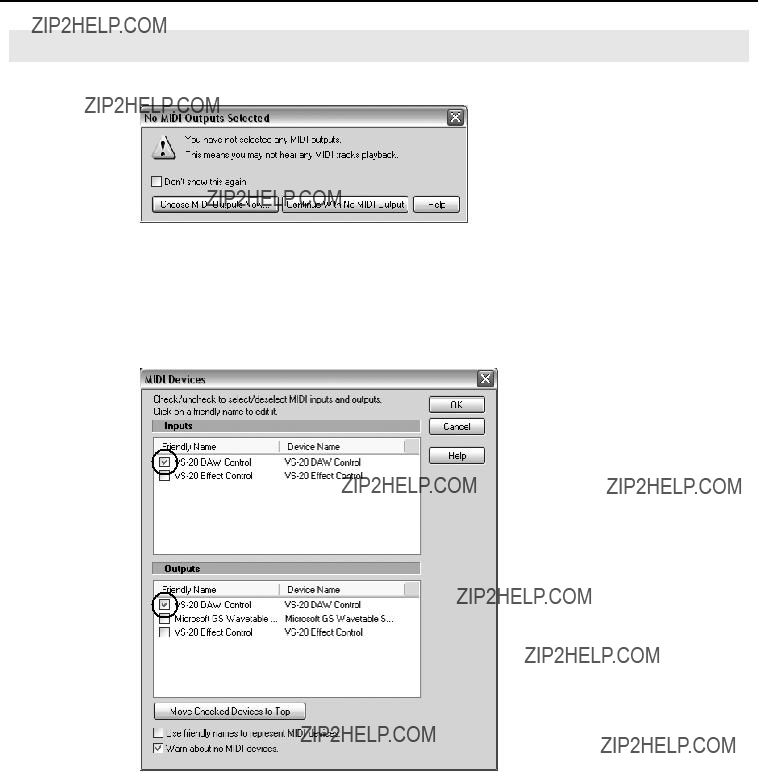
From initial settings to recording
Setting up MIDI Devices
If the
Here are the steps to set up the
1.To setup the MIDI connections, choose ???Options | MIDI Devices???.
In the input field and output field of the ???MIDI Devices??? dialog box, select the following MIDI devices that you will use with
2.The MIDI Devices dialogue box will be shown.
3.Check the boxes next to
4.Click [OK] to close the dialog box.
25

From initial settings to recording
Playing a Demo Song
Playing an Audio Demo Song
1.Start up Guitar Tracks 4, choose ???File | Open??? command to open the ???Open??? dialog box.
2.Select the project file ???Guitar_Tracks_Demo.cwp??? within the ???My Documents\Cakewalk\Guitar Tracks 4\Tutorials\Guitar_Tracks_Demo??? folder.
3.Click [Open] to open the project. Wait until the project has finished loading.
4.Press the  ] button.
] button.
5.Adjust the volume of the
(monitor speakers, etc.).
6. When you???ve finished listening to the demo song, choose ???File | Close.??? If you???re asked whether you want to save the changes, click [No].
This controls the volume that's
output from OUTPUT and PHONES.
DIRECT
*Use of the demo song supplied with this product for any purpose other than private, personal enjoyment without the permission of the copyright holder is prohibited by law. Additionally, this data must not be copied, nor used in a secondary copyrighted work without the permission of the copyright holder.
26

From initial settings to recording
If you don???t hear demo project
Review the following steps to try to resolve it.
I did not see any meters move in Guitar Tracks or hear any sound
The most common cause of this is if the playback device is not set correctly.
In most cases, you can correct this by following these steps:
???On the Options menu, click Audio to open the Audio Options dialog.
???Make sure the driver mode is set to ???ASIO???
???Make sure you have
If you do not see an option for
I can see meters moving in Guitar Tracks, but I don't hear anything
???Make sure the ???Output Level??? on the
???Make sure the ???DAW Output??? on the
Audio starts to play, but I get a message that says DROPOUT or AUDIO STOPPED either in a dialog or across the bottom of the screen
A dropout is a symptom of audio hardware when it is unable to pass audio data fast enough. There are a few things that may alleviate this:
???Check the settings described in ???Setting up Audio Devices??? (p. 24)
???Ensure nothing else is trying to use the sound device at the same time. Guitar Tracks will perform best when there are no other software applications attempting to use the sound device, such as web browsers, video players, instant messaging clients and other sound applications.
27
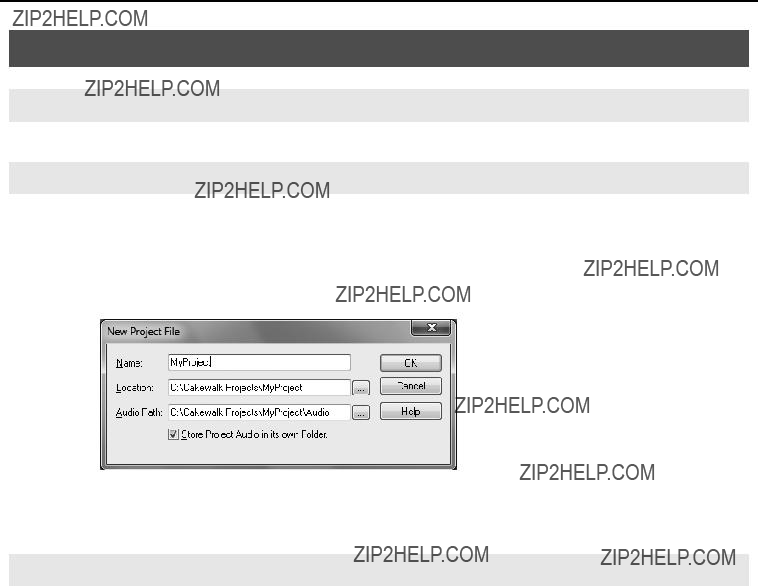
From initial settings to recording
Recording audio
1. Connect your instrument or microphone
In order to record audio, you???ll connect your instrument or microphone to the
2.Create a new file
1.Launch Guitar Tracks 4.
2.From the File | New to open the New Project File dialog box.
3.In the Name field of the New Project File dialog box, enter the name of the song that you want to create.
A new project will be created.
In this example we???re going to record on track 1.
3. Select the input source
Now we???ll configure input settings in Guitar Tracks 4 as appropriate for the input you connected.
1. From the top panel of the
28
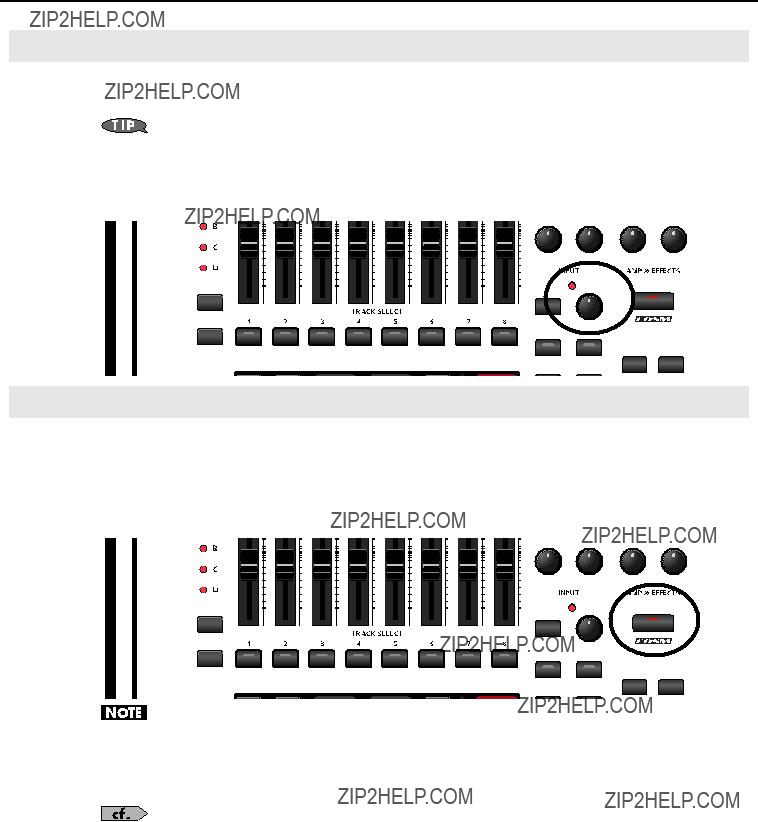
From initial settings to recording
4. Adjust the level
In order to record with the best possible audio quality, adjust the input level so that
With the DIRECT MONITOR knob turned down, turn the SENS knob until you see the red light come on. Then turn SENS knob down just until the peak light goes off.
1. Use the [SENS] knob on the
5. Try out an effect.
In this example, we???ll apply a effect to the input signal you perform.
1.Press the [COSM] button on the
The
If the Editor is already open, pressing the COSM button will bypass the effect. To view the Editor simply click on the
2. Use PATCH SELECT [<] [>] to select the desired effect patch.
For details on how to edit the effects, refer to
29

From initial settings to recording
6. Arm the desired track for recording.
We???ll arm track 1 for recording (i.e. put it in
1.Press the
The
You can also arm the track by clicking the TRACK SELECT button on Track 1 in Guitar Tracks.
30

From initial settings to recording
7.Set tempo.
1.In Guitar Tracks 4???s toolbar,
Enter a numerical value from your computer keyboard, and press the Enter key to confirm it.
This completes preparations for recording.
31
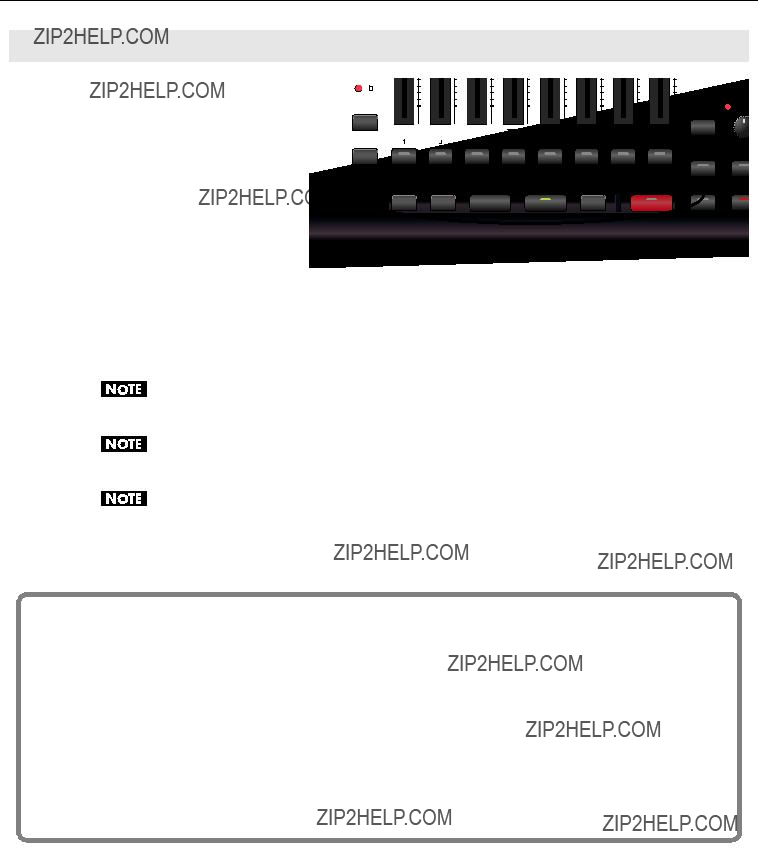
From initial settings to recording
8. Record your performance.
Press the [  ] record button to start recording.
] record button to start recording.
Press the [  ] stop button to stop recording.
] stop button to stop recording.
Press the [  ] play button to hear the recorded result.
] play button to hear the recorded result.
If you???re not satisfied with your performance, you can easily
The sound of playback or recording may be interrupted if you connect or disconnect USB memory or another USB device or turn the power on/off during these operations.
Using a
Dropouts in playback or recording may occur immediately after the system has started up or resumed from the sleep state. Please wait for a time before you perform playback or recording.
You've successfully used the included software to make a recording.
About the online help video
If you need help at anytime during the process, you can select a topic from the integrated help menu in the console view and a video will show you how to use the feature.
You will need an active internet connection in order to view the videos.
-SELECT INPUT
-ADD EFFECTS
32


 Troubleshooting
Troubleshooting
1.This chapter lists problems that might occur when setting up this product, and explains how to solve these problems. If you experience a problem during installation, read this chapter first.
2.If the system still does not operate as you expect even though you???ve checked the points listed in this chapter, refer to the following documents as well.
Online Help
Guitar Tracks 4???s online Help is an organized collection of information that covers everything from operation to full details of all functions and commands. To view this, launch Guitar Tracks 4, and from the Help | Help Topics. You can open the Search tab and type a keyword to search for related topics.
README.RTF (online document; Rich Text Format)
This contains supplementary information about Guitar Tracks 4, information about changes from older versions of Cakewalk products, and cautions regarding use in specific types of systems. To view this, access Guitar Tracks 4???s Help
| View README.RTF.
Cakewalk Website
For the latest information, tech tips and knowledge base articles visit;
http://www.cakewalk.com/support/vstudio
For registration visit;
http://www.cakewalk.com/register
For Support and Service Contact Information;
http://www.cakewalk.com/support/contact.aspx
33

Troubleshooting
Problems When Installing Driver or Changing Settings
34

Troubleshooting
35

Troubleshooting
Problems When Installing Guitar Tracks 4 or Changing Settings
36

Troubleshooting
Problems at Startup with Guitar Tracks 4
37

Troubleshooting
Problems with Playback
38

Troubleshooting
39

Troubleshooting
Problems with Recording
40

Troubleshooting
41

Troubleshooting
Eliminating Clicks and Dropouts
If data cannot be recorded while recording audio, or if data cannot be fully processed during playback, Guitar Tracks 4 will automatically halt. This is called a dropout. Clicks or pops may also occur if problems occur in communication between Guitar Tracks 4 and the
There are a variety of possible reasons why clicks, pops, and dropouts might occur. To eliminate the cause of the problem, follow the checkpoints listed below.
If problems occurs even with small projects
Increase the Mixing Latency
Extremely short Mixing Latency settings will place an excessive processing load on your computer.
???About Mixing Latency??? (p. 46)
Try changing the Driver Mode
Since the
???Audio Driver Settings??? (p. 24)
Install the correct device driver
Even for your
Lower the screen resolution
Some computers have graphics functionality that places a heavy load on the CPU. You may be able to lighten this load by lowering the screen resolution.
Uninstall the drivers of audio interfaces you???re not using
Some audio interfaces not intended for use in music production may cause problems with other audio interfaces (e.g. the
Disable other hardware devices
Other hardware devices may interfere with the performance of your audio device. We recommend that you disable any unnecessary hardware devices, such as network adapters and internal sound cards.
42

Troubleshooting
If problems occur more frequently with large (heavy) projects
Increase the Mixing Latency
Extremely short Mixing Latency settings may place an excessive load on your computer.
???About Mixing Latency??? (p. 46)
Use freezing or bouncing to reduce the load on your computer
If the size of the project exceeds the processing capability of your computer, you can reduce the processing load by freezing synthesizers or bouncing audio tracks.
Update the driver of your audio device
In most cases, newer driver versions of the audio interface will have fewer problems and improved performance.
Close other programs
If other programs are running, they will reduce the CPU resources and memory that are available to Guitar Tracks 4. It is best to close all programs that are not needed for your work.
Change the
In some cases, reducing the
1.Before you change the driver settings, you must close all programs that are using the
2.Got to your Windows task bar and select Start | Control Panel |
*If you don???t see the above icon, click ???Switch to classic view.??? The
3.Adjust the ???Audio Buffer Size.???
To change the setting, make the desired setting and click [OK]. If you merely want to view the setting without changing it, be sure to click [Cancel] after you???ve noted the setting.
*???Launch Audio Profiler...??? in the Audio Options dialogue in Guitar Tracks if you???ve changed the buffer size (unless you???re using ASIO mode).
43
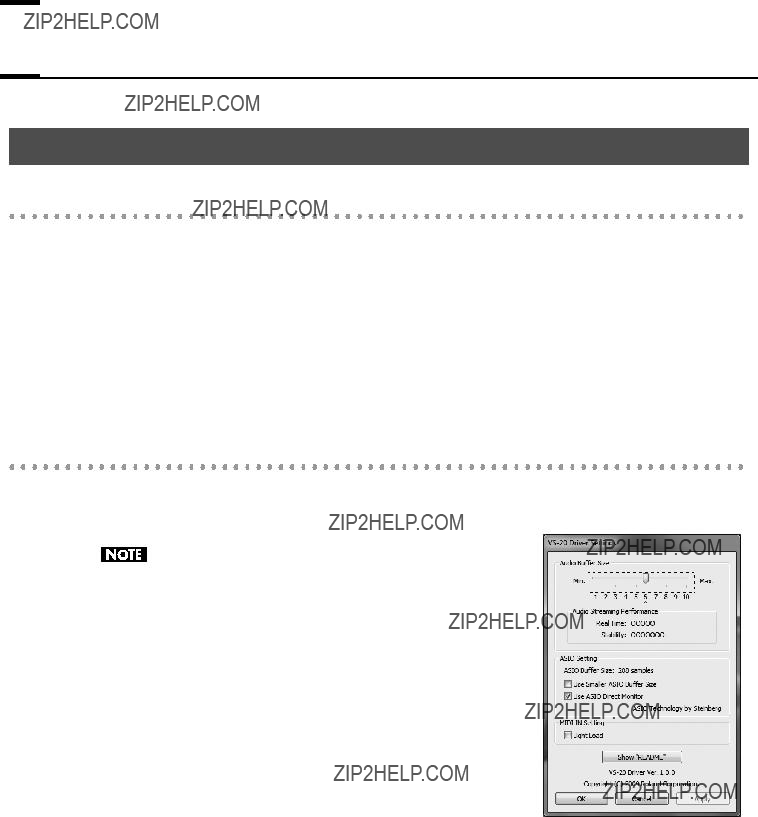

 Appendix
Appendix
Changing or Viewing the Settings
1.When changing driver settings, always make sure to first quit all applications using the
2.Open the ???Control Panel,??? and
* If the above icon cannot be found, click the ???Switch to Classic View.???
The
3.To modify the settings, make the changes and click [OK]. To simply check the settings, be sure to click [Cancel] after viewing the settings.
Controls in the Settings Dialog Box
Audio Buffer Size
Ordinarily, set the sixth position from the left for the buffer size.
After you???ve changed the ???Audio Buffer Size,??? make sure to restart all applications which are using the
Also, you may want to check to see if your application is one of those that provides a setting for adjusting the buffer size.
???Use Smaller ASIO Buffer Size??? check box
If this check box is selected, the buffer size when using
If you experience pops or clicks when this check box is selected, deselect this check box.
* You must deselect this check box when adjusting the ???Audio Buffer Size.???
Information
This field shows the driver version.
44
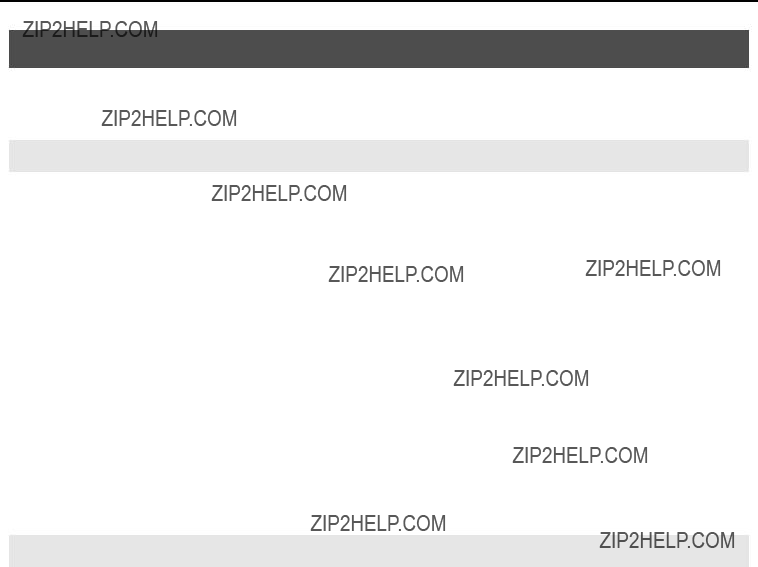
Appendix
Uninstalling
If you connect the
Then install the
Windows 7 and Windows Vista Users
1.Start up Windows with all USB cables disconnected (except those for a USB keyboard and/or USB mouse, if used).
2.Close all applications before performing the uninstallation.
3.Insert the included
4.Select
(where d:\ is your disc drive.)
5.If a dialog box regarding User Account Control appears, click [Continue].
* If you are asked to enter the password for an administrative account, log on to Windows as a user whose account type is Administrator, and then perform the uninstallation.
6.The display will indicate ???The installed
7.When the message ???Uninstallation was completed.??? is displayed, click [OK] to restart Windows.
Windows XP Users
1.Start up Windows with all USB cables disconnected (except those for a USB keyboard and/or USB mouse, if used).
2.Close all applications before performing the uninstallation.
3.Insert the included
4.Select
(where d:\ is your disc drive.)
5.The display will indicate ???The installed
* If any other message appears, follow the directions of the message.
6.When the message ???Uninstallation was completed.??? is displayed, click [OK] to restart Windows.
45

Appendix
About Mixing Latency
If the driver mode is set to ASIO, you won???t be able to adjust the Mixing Latency from Guitar Tracks 4. Adjust the ???Audio Buffer Size??? from the [ASIO Panel].
To access the ASIO panel, Choose Option|Audio... then click the button labelled ASIO Panel.
The Mixing Latency setting is closely related to how Guitar Tracks 4 can take full advantage of your computer???s performance. Increasing the mixing latency will allow more audio processing to be performed within Guitar Tracks 4. However, increasing the mixing latency will lengthen the time (latency) from when Guitar Tracks 4 begins processing the audio until you actually hear the sound. Increasing the latency will adversely affect your MIDI keyboard playing.
The most suitable Mixing Latency setting will depend on the performance of your computer and on various settings. If you experience the following problems with the default settings, try adjusting the mixing latency.
Interruptions or dropouts occur during playback in Guitar Tracks 4
You may be able to reduce interruptions or dropouts by increasing the Mixing Latency. To adjust the latency, go to
Options|Audio...
46
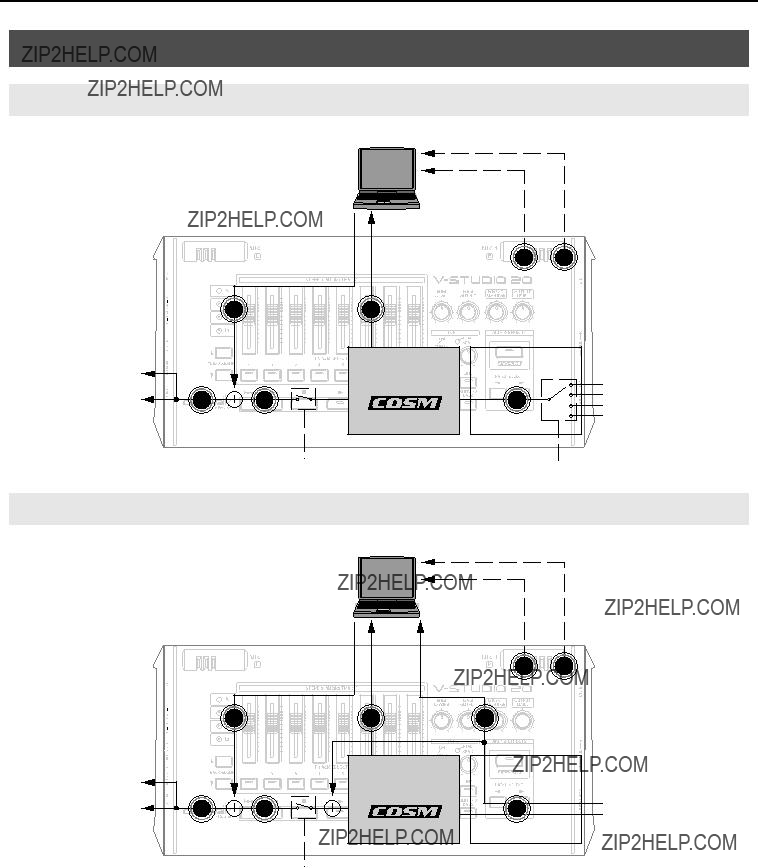
Appendix
Signal Flow
Normal
Computer
MIDI DAW
BACKING OUTPUT
INPUT SECTION
INPUT
SENS
GUITAR/BASS
LINE
MIC 1
MIC 2
Simultaneous Recording
Computer
DIRECT MONITOR
47
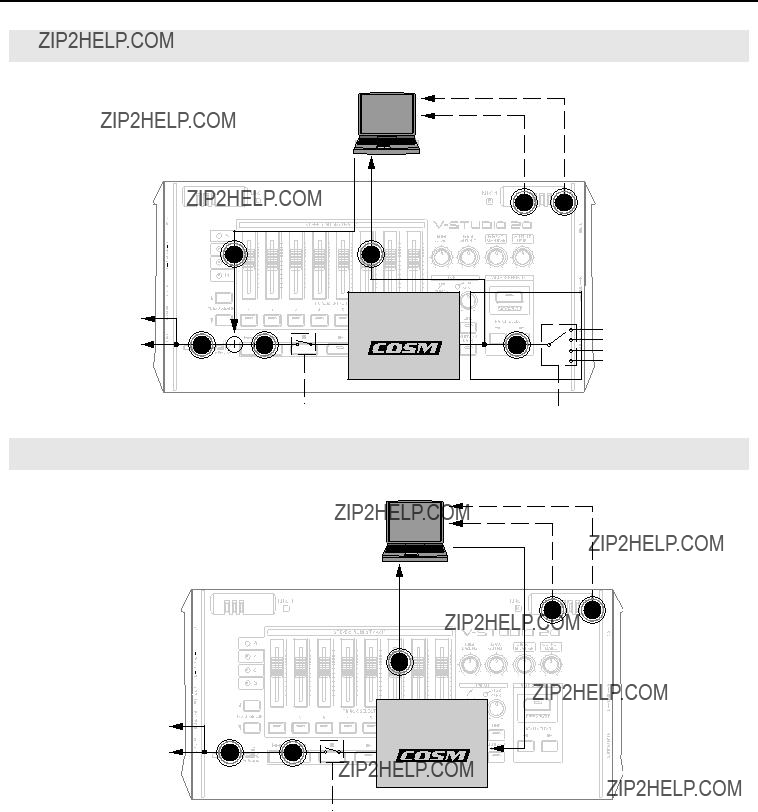
Appendix
Dry Recording
Computer
Reamping
MIDI DAW
BACKING OUTPUT
DIRECT MONITOR
48

Appendix
Specifications
Digital Audio Workstation:
Audio Interface
*0 dBu = 0.775 Vrms
*In the interest of product improvement, the specifications and/or appearance of this unit are subject to change without prior notice.
49

Appendix
For China
For EU Countries
50
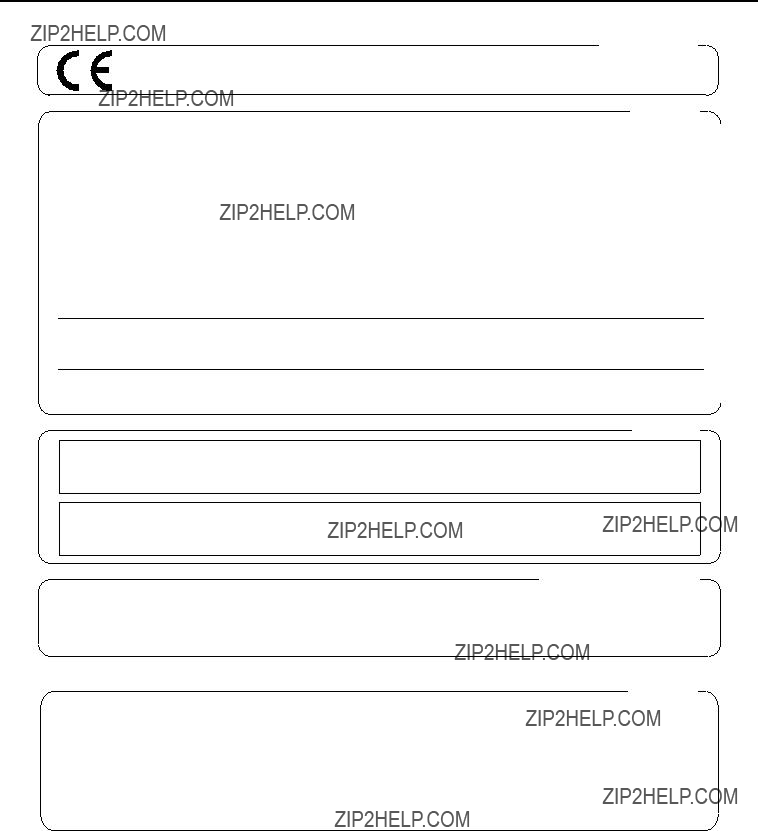
Appendix
For EU Countries
This product complies with the requirements of EMC Directive 2004/108/EC.
For the USA
FEDERAL COMMUNICATIONS COMMISSION
RADIO FREQUENCY INTERFERENCE STATEMENT
This equipment has been tested and found to comply with the limits for a Class B digital device, pursuant to Part 15 of the FCC Rules. These limits are designed to provide reasonable protection against harmful interference in a residential installation. This equipment generates, uses, and can radiate radio frequency energy and, if not installed and used in accordance with the instructions, may cause harmful interference to radio communications. However, there is no guarantee that interference will not occur in a particular installation. If this equipment does cause harmful interference to radio or television reception, which can be determined by turning the equipment off and on, the user is encouraged to try to correct the interference by one or more of the following measures:
???Reorient or relocate the receiving antenna.
???Increase the separation between the equipment and receiver.
???Connect the equipment into an outlet on a circuit different from that to which the receiver is connected.
???Consult the dealer or an experienced radio/TV technician for help.
This device complies with Part 15 of the FCC Rules. Operation is subject to the following two conditions:
(1)this device may not cause harmful interference, and
(2)this device must accept any interference received, including interference that may cause undesired operation.
Unauthorized changes or modification to this system can void the users authority to operate this equipment. This equipment requires shielded interface cables in order to meet FCC class B Limit.
For Canada
NOTICE
This Class B digital apparatus meets all requirements of the Canadian
AVIS
Cet appareil num??rique de la classe B respecte toutes les exigences du R??glement sur le mat??riel brouilleur du Canada.
For C.A. US (Proposition 65)
WARNING
This product contains chemicals known to cause cancer, birth defects and other reproductive harm, including lead.
For the USA
51
